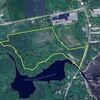Processing Your Payment
Please do not leave this page until complete. This can take a few moments.
Rehab projects rolling along Kennebec | Historic restorations along the Kennebec in Augusta and Waterville keep the development flowing
 Photo/David A. Rodgers
Paul Boghossian inside the former Hathaway shirt factory in Waterville
Photo/David A. Rodgers
Paul Boghossian inside the former Hathaway shirt factory in Waterville
Paul Boghossian peers through the windows of the MaineGeneral office on the third floor of the old Hathaway mill building in Waterville, and points out some of the details of a conference room. It takes full advantage of the interior brick walls and huge wooden beams characteristic of the old mills that once dominated Maine’s urban streetscapes.
Like TD Insurance on the floor above, the Augusta-based hospital’s administrative offices moved in early, long before the April 2009 occupancy date originally envisioned for tenants.
But Boghossian, a Rhode Island-based developer who has made Maine his second home, and his partner, Tom Niemann of Durham, N.C., are used to moving fast to accommodate clients. So construction on the five floors of the mill continues around the tenants, as work crews share space with commuters in the parking lot along the Kennebec River.
The Hathaway building, part of a large, three-building complex known as the Lockwood Mills, made textiles and then the famed Hathaway shirts for more than a century before the machines fell silent in 2003.
Like another historic property known as the Kennebec Arsenal in Augusta, the Hathaway mill revitalization is a test case for a historic tax credit program created by the Legislature that has now been expanded to development statewide (See “Tax credits spur preservation,” below).
Niemann’s Arsenal project was the first to get special tax treatment, with legislation approved in 2006. But the Hathaway building, whose tax increment financing district was created in 2007, is where construction has gotten under way first, for good reason.
The 200,000 square feet of space on five floors of Hathaway are relatively easy to design and alter, depending on changes in the marketplace, said Shannon Bain, a spokesman for Niemann Capital, the North Carolina company involved in both projects.
The Arsenal, the oldest intact military installation of its kind in the country, consists of six stone buildings totaling 66,000 square feet. Originally scheduled to start in 2008, construction is now expected to begin this fall, after developers obtain financing and planning approvals, according to Scott Hayes, vice president for development in Niemann’s Maine office.
The mix of uses has also shifted significantly. Originally, Niemann had hoped to market retail and commercial space in the main structure, known as the Burleigh Building, which faces the Kennebec and is highly visible from the heavily traveled Memorial Bridge. Instead, the building is now slated for 11 to 12 one- and two-bedroom apartments, while the Barracks building, with its thick stone walls, appears more adaptable to dormitory-style student housing, Bain said. The company believes there is a market for University of Maine at Augusta students, which has residential students but no dormitories.
Five smaller buildings, including the Arsenal Gatehouse, will house a few condos and apartments apiece, with some professional space and perhaps a student office on the first floors of Burleigh and the Barracks.
“The market has obviously fallen sharply for business expansions and startups,” said Augusta City Manager Bill Bridgeo. “We’re just glad they’re going ahead at this point.”
Augusta’s economic development director, Mike Duguay, said that because Niemann isn’t building new space or substantially altering the existing buildings, the firm will need only minor planning approvals before construction can begin.
Hayes said that the last major hurdle is the financing package, and with a combination of private capital and public sector underwriting, that’s likely to be completed by the end of January.
Down the road, Niemann would like to build some additional units, and a waterfront wharf or marina is featured in the company’s original plans for the area.
Tom Niemann credits Elaine Clark, former head of the state Bureau of General Services, with spearheading interest in the Arsenal property, which had lain idle since the last Augusta Mental Health Institute patients moved out more than 20 years ago. “Getting the federal grant that restored the riverfront and let people see what was there was critical to driving interest in the project,” said Niemann, referring to an America’s Treasures grant from the National Endowment for the Arts acquired by Clark.
Hayes said that the only changes to the grounds are likely to be restoration of some of the original landscape features, as shown in old photos. A double line of elms, for instance, once flanked the entrance road, which, like the current drives and parking areas, will remain intact.
Market for apartments beckons
Back in Waterville, Paul Boghossian seems relieved that the Hathaway construction is going full-tilt, even as countless commercial projects in Maine and elsewhere are being delayed or shut down.
Upstairs, the one- and two-bedroom apartments under construction on the top two floors feature huge windows — all newly installed — and expansive views over the Kennebec. With 12- and 13-foot ceilings, the units “appear much larger than they actually are,” he said.
Market-rate rents for two-bedroom units run from $1,000 to $1,300 a month, while one-bedrooms range from $600 to $900. There are a few affordable-housing units as well. Boghossian said interest in the apartments has been strong, and the company has already taken deposits for occupancy in the spring.
In fact, the interest has been strong enough for the partners to move ahead on plans for the other two Lockwood buildings, one most recently a Central Maine Power warehouse, the other used for storage by Marden’s.
Downstairs, space for four radio stations, including Mix 107.9 and The River 93.5, is taking shape on the first floor. “They really like the ‘Today Show’ atmosphere for broadcasting,” he said, with large windows allowing passersby a clear view. On the second floor, a salon and spa plans to locate its lounge chairs facing the windows, which stream sunlight even on a cold winter day. The spa, rather appropriately, will be called Rejuvenation, and will cater to aging baby boomers.
Boghossian says he’s not sure the Waterville community has really noticed what’s going on, even though more than 200 MaineGeneral employees are at work there, plus 70 from TD Insurance. Ultimately, more than 500 people will work in the complex, with several hundred living on the top floors.
“The building is in such good shape that we really didn’t have to do much to the exterior,” he said. Inside, some of the tenants prefer carpeting, but Boghossian likes the existing wood floors, which glow when sanded and finished.
When spring rolls around and retail shops begin occupying the first two floors, he expects there to be more buzz. A café has signed up, and he’s looking for a first-class restaurant. Smaller art galleries and craft shops are also expected to be part of the mix.
Boghossian, like Niemann, specializes in old mills and historic buildings, and hasn’t attempted to branch out beyond them.
“It’s what we know and what we’re good at,” Niemann said. “The kind of community support that’s been generated is really what makes this work.”
Boghossian said he’s looking at a couple of other Maine downtowns for possible projects, but declined to name them. He said at this point he’s not planning to use any outside financing for new ventures, which means they will likely be smaller than the Lockwood Mill complex. “I’m not going to take on anything I can’t finance myself,” he said. “At this point, it’s pretty much the bank of Paul,” he joked.
Since Rhode Island has effectively ended its program to rehabilitate historic buildings, Boghossian sees his future as a developer largely in Maine.
“Maine has made the right moves” to encourage economic development, despite the slump, he said. “I really see this state doing better.”
Douglas Rooks, a writer in West Gardiner, can be reached at editorial@mainebiz.biz.










Comments